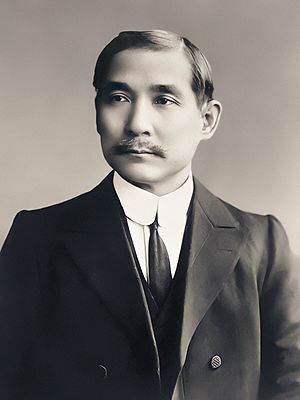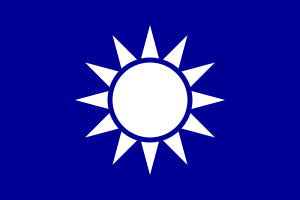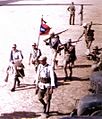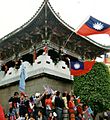Kuomintang facts for kids
The Kuomintang (KMT) is a major political party in Taiwan, also known as the Republic of China. It was once the ruling party in Mainland China. In 1949, after a civil war, the KMT moved its government to Taiwan when Communists took control of the mainland.
The party was started by Song Jiaoren and Sun Yat-sen. Later, Chiang Kai-shek became a very important leader and led the party for many years.
Contents
The Start of the Kuomintang
The Kuomintang was founded in 1912 in China. Its main goal was to create a modern, democratic China. The party's first leader was Sun Yat-sen, who is often called the "Father of the Nation" in Taiwan. He wanted China to be strong and independent.
Early Goals and Ideas
Sun Yat-sen developed a set of ideas for the KMT called the "Three Principles of the People." These principles were:
- Nationalism: Making China a strong and united country, free from foreign control.
- Democracy: Giving people the right to vote and choose their leaders.
- People's Livelihood: Making sure everyone had a good life, with enough food, housing, and opportunities.
These ideas guided the KMT as it tried to bring stability to China after the fall of the old empire.
Key Leaders of the KMT
The Kuomintang has had several important leaders throughout its history.
Sun Yat-sen: The Founder

Sun Yat-sen was a doctor and a revolutionary. He spent many years trying to overthrow the old imperial system in China. After the empire fell, he helped create the Republic of China and the KMT. He believed that China needed to learn from Western countries to become strong, but also keep its own culture.
Chiang Kai-shek: A Long-Time Leader

After Sun Yat-sen's death in 1925, Chiang Kai-shek became the most powerful leader of the KMT. He was a military general who helped unite much of China under KMT rule during the Northern Expedition. Chiang Kai-shek led the KMT through many challenges, including fighting against Japan in the Second Sino-Japanese War and later against the Communists in the Chinese Civil War.
The KMT Moves to Taiwan
After World War II, the civil war between the KMT and the Communists grew very intense. In 1949, the Communists won control of mainland China. Chiang Kai-shek and the KMT government, along with many of their supporters, moved to Taiwan.
Building Taiwan
Once in Taiwan, the KMT continued to govern. They focused on developing Taiwan's economy and infrastructure. They also kept their claim to be the rightful government of all China. For many years, Taiwan was under one-party rule by the KMT.
The KMT Today
Today, the Kuomintang is still one of the two main political parties in Taiwan. It plays an important role in Taiwan's democratic system. The party has changed over time, adapting to the needs of a modern, democratic society. It continues to be a major force in Taiwanese politics, competing in elections and helping to shape the country's future.
Images for kids
-
The Revolutionary Army attacking Nanjing in 1911
-
Nationalist soldiers during the Second Sino-Japanese War
-
The retrocession of Taiwan in Taipei on 25 October 1945
-
The former KMT headquarters in Taipei City (1949–2006)
-
Lien Chan (middle) and Wu Po-hsiung (second left) and the KMT touring the Sun Yat-sen Mausoleum in Nanjing, People's Republic of China when the Pan-Blue coalition visited the mainland in 2005
-
KMT Kinmen headquarters office in Jincheng Township, Kinmen County
-
KMT Building in Vancouver's Chinatown, British Columbia, Canada
-
KMT branch office in Pingzhen District, Taoyuan City
-
The KMT maintains offices in some of the Chinatowns of the world, like in San Francisco Chinatown
-
KMT Eastern U.S. headquarters is in New York Chinatown
-
KMT office of Australasia in Sydney, Australia
-
From left to right, KMT members pay tribute to the Sun Yat-sen Mausoleum in Beijing in 1928 after the success of the Northern Expedition: Generals Cheng Jin, Zhang Zuobao, Chen Diaoyuan, Chiang Kai-shek, Woo Tsin-hang, Yan Xishan, General Ma Fuxiang, Ma Sida and General Bai Chongxi
See also
 In Spanish: Kuomintang para niños
In Spanish: Kuomintang para niños






















